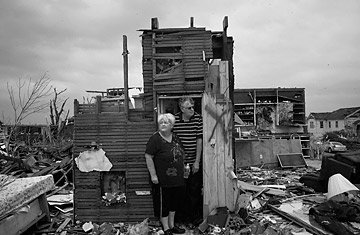
Ed Boyd pulled his wife Kay away from the tub she was heading for and into a closet under their stairs
(2 of 3)
Storm Surge
It was the deadliest tornado in the 61 years that the National Weather
Service has been keeping official statistics: 123 bodies counted by May 25,
with crews still searching for more. At its most furious, the half-mile-wide
killer maxed out on the Enhanced Fujita scale — EF-5, spinning winds in
excess of 200 m.p.h. The power of such a phenomenon is difficult to
describe: It snaps utility poles like pencils, tears the door handles from
cars, crumbles brick walls the way a child crumbles cookies. It blows floor
joists like straw, drives twigs through plate glass, strips the bark from
trees, rains automobiles.
No one in Joplin — a growing community in southwestern Missouri where the Show Me State meets up with Oklahoma and Kansas — expected such a storm, though perhaps people should have. Joplin is smack in the middle of Tornado Alley, and the tornadoes have been frequent and furious this year. Just weeks earlier, a squadron of twisters, some EF-5, tore through Tuscaloosa, Ala., on a rampage through the South. Is this the "climate chaos" that scientists of global warming have been warning about? At the opposite end of Missouri from Joplin, miles of prime farmland lie soaked under the record flood-waters overflowing the Mississippi and its tributaries. Pattern or coincidence?
The answer awaits more data. The heat-trapping effect of greenhouse gases is well proved; the precise impacts on local climates are less clear. Whirlwinds and floods have been with us forever — old hat even in the days of the Bible scribes. But as humankind multiplies and spreads, more and more people risk encountering extreme and deadly weather.
So far this year, tornadoes have killed more than 500 Americans and destroyed billions of dollars' worth of property — and the season is far from over. Perhaps the surprise is that the toll is not even higher. The population of the U.S. has more than doubled since 1950 and sprawled. Thousands of square miles have been populated in the tornado zone in the suburbs and exurbs of cities like Dallas, Kansas City, Mo., and Nashville. Where a farmhouse once stood amid rolling acres of cropland, there are now rows of McMansions or fields of townhouses convenient to shopping, schools and church.
We can cover the land and alter the atmosphere, but we can't change the rules of nature. Warm air rises.
Grief and Gratitude
Hollie Hounschell, 26, was preparing for a party on Sunday night, one ear to
the TV as she painted her nails, the other cocked for the doorbell. Her ex,
Joe Winters, was due to drop off their daughter Abigail. She took in the
news that hail was falling in Webb City, some seven miles north of Joplin.
After a rough passage, things were coming together for Hounschell. Her landlord had finally patched the holes in the bedroom and the kitchen and applied a fresh coat of the paint she'd picked out — a warm shade of green. Now she could unpack her stuff and make that new start that comes with feeling settled in.
Ding dong. When Hounschell opened the front door, she noticed lightning slashing the sky behind Abigail and her father. Suddenly McArdle's voice was rising from the TV: "Take cover!" Hounschell had a basement, but not everyone was so lucky. A couple of bewildered neighbors appeared at the door begging for help. In all, five people hurried down the hall and into the tiny cellar as wood splinters — some of them freshly painted green — and knives of broken glass and needles of fiberglass insulation scoured the air. The neighborhood turned into fragments.
